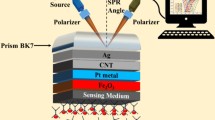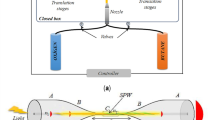Abstract
A design of high sensitivity Vivaldi antenna is introduced for detecting the low sugar and salt concentrations in water. The reason for selecting the Vivaldi antenna configuration is to provide two desired features; ultra-wideband and a high directivity so the surrounding clutter effect can be minimized. The prospective antenna embraces the ultra-wideband from 4 to 11 GHz. Two techniques are exploited to improve the antenna detectability; epsilon-near-zero (ENZ) metamaterial and antenna aperture amending. The ENZ metamaterial is very sensitive to the permittivity of the substrate, so any loading effect can easily alter the electric field distribution and hence affect the antenna phase properties. The aperture amending is used to improve substrate-air matching. An equivalent circuit model is scrutinized for further emphasis of the ENZ metamaterial operation, showing good agreement with EM simulation results. In terms of phase variation, the designed antenna is employed to sense sugar and salt in water. The amount of sugar and salt affects the material characteristics of the solution and, as a result, the reflected phases. Practical observations reveal that when the sugar and salt contents in the liquid increase, the phase falls. At 5 GHz the difference between the highest and lowest sugar concentrations is about 3° in the sugar case and 5° in the salt case, but at 8 GHz, the phase difference is about 30o in the sugar case and about 50° in the salt case. The sensitivity can be increased by operating at a higher frequency since the proposed antenna can detect very low levels (1%) of salt and sugar concentrations. The time-domain analysis is discussed, revealing low distortion of received pulses.


















Similar content being viewed by others
Data availability
Enquiries about data availability should be directed to the authors.
Code availability
Enquiries about code availability should be directed to the authors.
References
Bertuzzo, E., & Mari, L. (2017). Hydrology, water resources and the epidemiology of water-related diseases. Advances in Water Resources, 108, 329–331.
Afrand, M., Esfe, M. H., Abedini, E., & Teimouri, H. (2017). Predicting the effects of magnesium oxide nanoparticles and temperature on the thermal conductivity of water using artificial neural network and experimental data. Physica E: Low-dimensional Systems and Nanostructures, 87, 242–247.
Zhang, C., Ye, H., Liu, F., He, Y., Kong, W., & Sheng, K. (2016). Determination and visualization of pH values in anaerobic digestion of water hyacinth and rice straw mixtures using hyperspectral imaging with wavelet transform denoising and variable selection. Sensors, 16(2), 244.
Kim, T. Y., Hong, S. A., & Yang, S. (2015). A solid-state thin-film Ag/AgCl reference electrode coated with graphene oxide and its use in a pH sensor. Sensors, 15(3), 6469–6482.
Mohammad, A. M., Chowdhury, T., Biswas, B., & Absar, N. (2018). Food poisoning and intoxication: A global leading concern for human health. Food safety and preservation (pp. 307–352). Academic Press.
Posudin, Y., Peiris, K., & Kays, S. (2015). Non-destructive detection of food adulteration to guarantee human health and safety. Ukrainian Food Journal, 4(2), 1–54.
Haq, M. A. U., Armghan, A., Aliqab, K., & Alsharari, M. (2023). A Review of contemporary microwave antenna sensors: Designs, fabrication techniques, and potential application. IEEE Access, 11, 40064–40074.
Gartley, K. L. (2011). Recommended methods for measuring soluble salts in soils. Recommended soil testing procedures for the northeastern United States. Northeastern Regional Publication, 493, 1864–1872.
Bircan, C., & Barringer, S. A. (1998). Salt-starch interactions as evidenced by viscosity and dielectric property measurements. Journal of Food Science, 63(6), 983–986.
Omer, A. E., Shaker, G., Safavi-Naeini, S., Ngo, K., Shubair, R. M., Alquié, G., & Kokabi, H. (2020). Multiple-cell microfluidic dielectric resonator for liquid sensing applications. IEEE Sensors Journal, 21(5), 6094–6104.
Bhushan, S., Kumar, S., Singh, N., & Kumar, S. (2021). Defected ground split ring resonator-based sensor for adulteration detection in fluids. Wireless Personal Communications, 121, 1593–1606.
Govind, G., & Akhtar, M. J. (2019). Metamaterial-inspired microwave microfluidic sensor for glucose monitoring in aqueous solutions. IEEE Sensors Journal, 19(24), 11900–11907.
Cheng, E. M., Fareq, M., Shahriman, A. B., Mohd Afendi, R., Lee, Y. S., Khor, S. F., & Jusoh, M. A. (2014). Development of microstrip patch antenna sensing system for salinity and sugar detection in water. International Journal of Mechanical and Mechatronics Engineering, 15(5), 31–36.
Rahman, M. N., Islam, M. T., & Samsuzzaman Sobuz, M. (2018). Salinity and sugar detection system using microstrip patch antenna. Microwave and Optical Technology Letters, 60(5), 1092–1096.
Islam, M. T., Rahman, M. N., Singh, M. S. J., & Samsuzzaman, M. (2018). Detection of salt and sugar contents in water on the basis of dielectric properties using microstrip antenna-based sensor. IEEE Access, 6, 4118–4126.
Njokweni, S. N., & Kumar, P. (2020). Salt and sugar detection system using a compact microstrip patch antenna. Int J Smart Sensing Intell Syst, 13(1), 1–9.
Jain, S. (2022). Early detection of salt and sugar by microstrip moisture sensor based on direct transmission method. Wireless Personal Communications, 122(1), 593–601.
Kaur, J., & Khanna, R. (2022). Novel monkey-wrench-shaped microstrip patch sensor for food evaluation and analysis. Journal of the Science of Food and Agriculture, 102(4), 1443–1456.
Rahman, M. N., Hassan, S. A., Samsuzzaman, M., Singh, M. S. J., & Islam, M. T. (2019). Determination of salinity and sugar concentration using microwave sensor. Microwave and Optical Technology Letters, 61(2), 361–364.
El Gharbi, M., Martinez-Estrada, M., Fernández-García, R., & Gil, I. (2021). Determination of salinity and sugar concentration by means of a circular-ring monopole textile antenna-based sensor. IEEE Sensors Journal, 21(21), 23751–23760.
Harnsoongnoen, S. (2023). A non-contact method for detecting and distinguishing chloride and carbonate salts based on dielectric properties using a microstrip patch sensor. Chemosensors, 11(3), 158.
Devapriya, A. T., & Robinson, S. (2019). Investigation on metamaterial antenna for terahertz applications. Journal of Microwaves, Optoelectronics and Electromagnetic Applications, 18, 377–389.
Alu, A., Silveirinha, M. G., Salandrino, A., & Engheta, N. (2007). Epsilon-near-zero metamaterials and electromagnetic sources: Tailoring the radiation phase pattern. Physical review B, 75(15), 155410.
Nasir, M., Iftikhar, A., Shafique, M. F., Saka, B., Nikolaou, S., & Anagnostou, D. E. (2023). Broadband dual-podal multilayer Vivaldi antenna array for remote sensing applications. IET Microwaves, Antennas & Propagation. https://doi.org/10.1049/mia2.12354
Abd El-Hameed, A. S., Mahmoud, N., Barakat, A., Abdel-Rahman, A. B., Allam, A., & Pokharel, R. K. (2016). A 60-GHz on-chip tapered slot Vivaldi antenna with improved radiation characteristics. In 2016 10th European Conference on Antennas and Propagation (EuCAP) (pp. 1–5). IEEE.
Abd El-Hameed, A. S., Mahmoud, N., B arakat, A., Abdel-Rahman, A. B., Allam, A., & Pokharel, R. K. (2016, April). A 60-GHz on-chip tapered slot Vivaldi antenna with improved radiation characteristics. In 2016 10th European Conference on Antennas and Propagation (EuCAP) (pp. 1–5). IEEE.
Molaei, A., Kaboli, M., Mirtaheri, S. A., & Abrishamian, S. (2014, January). Beam-tilting improvement of balanced antipodal vivaldi antenna using a dielectric lens. In Proc. 2nd Iranian Conference on Engineering Electromagnetics (Vol. 577, p. 581).
Fei, P., Jiao, Y. C., Hu, W., & Zhang, F. S. (2011). A miniaturized antipodal Vivaldi antenna with improved radiation characteristics. IEEE antennas and wireless propagation letters, 10, 127–130.
Amiri, M., Tofigh, F., Ghafoorzadeh-Yazdi, A., & Abolhasan, M. (2017). Exponential antipodal Vivaldi antenna with exponential dielectric lens. IEEE Antennas and Wireless Propagation Letters, 16, 1792–1795.
Teni, G., Zhang, N., Qiu, J., & Zhang, P. (2013). Research on a novel miniaturized antipodal Vivaldi antenna with improved radiation. IEEE Antennas and Wireless Propagation Letters, 12, 417–420.
Popescu, A. S., Bendoym, I., Rexhepi, T., & Crouse, D. (2016). Anisotropic zero index material: A method of reducing the footprint of Vivaldi antennas in the UHF range. Progress In Electromagnetics Research C, 65, 33–43.
Budarapu, S. K., Sunder, M. S., & Ramakrishna, B. (2023). Performance enhancement of patch antenna using ris and metamaterial superstrate for wireless applications. Progress In Electromagnetics Research C, 130, 95–105.
El-Nady, S., Zamel, H. M., Hendy, M., Zekry, A. A., & Attiya, A. (2018). Gain enhancement of a millimeter wave antipodal vivaldi antenna by epsilon-near-zero metamaterial. Progress In Electromagnetics Research C, 85, 105–116.
Smith, D. R., Schultz, S., Markoš, P., & Soukoulis, C. M. (2002). Determination of effective permittivity and permeability of metamaterials from reflection and transmission coefficients. Physical review B, 65(19), 195104.
Zhou, B., Li, H., Zou, X., & Cui, T. J. (2011). Broadband and high-gain planar Vivaldi antennas based on inhomogeneous anisotropic zero-index metamaterials. Progress In Electromagnetics Research, 120, 235–247.
Abd El-Hameed, A. S., Wahab, M. G., Elboushi, A., & Elpeltagy, M. S. (2019). Miniaturized triple band-notched quasi-self complementary fractal antenna with improved characteristics for UWB applications. AEU-International Journal of Electronics and Communications, 108, 163–171.
Funding
This research has received no specific grant from any funding agency.
Author information
Authors and Affiliations
Corresponding author
Ethics declarations
Conflict of interest
The authors declare that there are no conflicts of interest regarding the publication of this paper.
Additional information
Publisher's Note
Springer Nature remains neutral with regard to jurisdictional claims in published maps and institutional affiliations.
Rights and permissions
Springer Nature or its licensor (e.g. a society or other partner) holds exclusive rights to this article under a publishing agreement with the author(s) or other rightsholder(s); author self-archiving of the accepted manuscript version of this article is solely governed by the terms of such publishing agreement and applicable law.
About this article
Cite this article
El-Nady, S., Afifi, A. & Abd El-Hameed, A.S. Sugar and Salt Concentration Detection in Water Employing ENZ Metamaterial Microwave Sensor. Wireless Pers Commun 134, 189–208 (2024). https://doi.org/10.1007/s11277-024-10899-6
Accepted:
Published:
Issue Date:
DOI: https://doi.org/10.1007/s11277-024-10899-6




